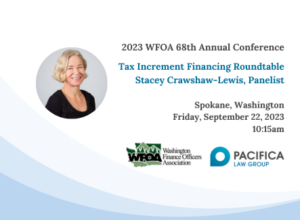
August 27, 2024
Municipal Bond Market Implications of Recent Federal Court Decisions and FDTA Rulemaking
Important changes to the municipal bond market are afoot thanks to recent federal court rulings and the issuance of joint proposed rules by U.S. regulators under the new Financial Data Transparency Act (“FDTA”).
In June 2024, the United State Supreme Court and the United States Court of Appeals for the First Circuit issued opinions on matters of significance for municipal debt issuers, ranging from bankruptcy to administrative law to securities enforcement proceedings.
Then, on August 22, a group of nine U.S. financial regulators, including the Securities and Exchange Commission, the Department of the Treasury, and the Federal Housing Finance Agency, published joint rules under the FDTA, which marks the first step in rulemaking under the FDTA.
Below is a brief summary of the court decisions and the data transparency rules as they relate to municipal bond issuances.
First Circuit Decision on Rights of Municipal Bondholders in Bankruptcy Proceedings
On June 12, 2024, the First Circuit issued a decision in In re Fin. Oversight & Mgmt. Bd. for Puerto Rico, 104 F.4th 367 (1st Cir. 2024), in which the Court considered the rights of the holders of certain revenue bonds (the “Bonds”) issued by the Puerto Rico Electric Power Authority (“PREPA”) before PREPA entered bankruptcy-type restructuring proceedings. 104 F.4th at 376. In reaching its ultimate determination that such Bondholders have a claim on PREPA’s estate for the principal amount of their bonds (thereby reversing the federal district court’s opinion), the Court articulated legal conclusions and reasoning of potential significance to municipal issuers.
First, applying Puerto Rico law to interpret the trust agreement at issue, the Court held that language in the agreement’s preamble pledging “the revenues of the System” as “security for the payment of” the Bonds was not merely prefatory, but instead established a security interest in such revenues. Id. at 382–83. In so holding, the Court rejected the notion that such an agreement must include “magic words” such as “lien” or “charge” to create a security interest; rather, the test is whether the agreement “indicate[s] an objective intent” to do so. Id. at 383 (internal alterations omitted).
Second, to determine the scope of the term “revenues of the System,” which the agreement did not explicitly define, the Court looked to the agreement’s provision requiring an opinion of counsel to accompany any bond issuance. Id. at 384. Under this provision, such an opinion must affirm the agreement’s creation of “a legally valid and effective pledge of the Net Revenues [i.e., gross revenues minus expenses] and of the moneys, securities and funds held or set aside under [the] Agreement as security for the bonds.” Id. Citing this provision, the Court construed “revenues of the System” to mean all of PREPA’s Net Revenues, regardless of the fund into which they were deposited. Id. at 384–88. In reaching this holding, the Court rejected a proposed interpretation of the agreement under which the Bondholders’ collateral would consist only of those Net Revenues deposited into debt service funds, observing that such a reading was inconsistent with the expectations of “an objectively reasonable party to the transaction” and would be misleading to investors. Id. at 386.
Third, relying upon Puerto Rico law, the federal bankruptcy code, and prior case law, the Court held that the Bondholders’ lien on Net Revenues included not only current Net Revenues but also future Net Revenues that PREPA has not yet acquired. Id. at 388–90. As support, the Court specifically cited section 928 of the bankruptcy code for the proposition that debtors may permissibly grant liens on future special revenues (such as the Net Revenues pledged by PREPA) and “that such liens continue to attach to revenues acquired after the filing of a bankruptcy petition.” Id. at 388–89 (citing 11 U.S.C. § 928(a)).
Elsewhere in its opinion, the Court agreed with the Bondholders that their lien on Net Revenues was perfected (or will be perfected) and was therefore not avoidable in bankruptcy, id. at 391–95, and that the proper amount of the Bondholders’ claim is the face value of the bonds plus accrued interest (approximately $8.5 billion), id. at 396–98. The Court rejected, however, the Bondholder’s argument that it had recourse beyond the collateral securing the Bonds. In so holding, the Court cited section 927 of the bankruptcy code, which denies “special revenue bondholders any recourse to the general funds of a municipality, which are often subject to statutory or constitutional limits on debt issuance.” Id. at 399 (internal quotation marks omitted). Added the Court, “the Trust Agreement expressly states that the [Bonds] are not general obligations of the Commonwealth of Puerto Rico. So, section 927 applies, and the Bondholders’ recourse is limited to their collateral.” Id. (internal citations and alterations omitted).
As noted above, the First Circuit’s holdings and reasoning rest upon the Court’s interpretation of the specific language of the agreement at issue and the laws applicable to PREPA. Moreover, the Court’s opinion is not binding outside of the First Circuit, which includes only New England and Puerto Rico. Nonetheless, the Court’s opinion offers an instructive example of how a court may apply common contract law principles and reasonable investor expectations to resolve ambiguities in authorizing legislation and agreements, and apply federal bankruptcy law to define the scope of security pledged toward the payment of municipal bonds.
Supreme Court Overturns Chevron Deference, Opening Door to Legal Challenges to Actions of Municipal Issuers
On June 28, 2024, the Supreme Court issued its opinion in Loper Bright Enterprises v. Raimondo, 144 S. Ct. 2244 (2024), holding that, under the federal Administrative Procedure Act (the “APA”), federal courts may no longer defer to agency interpretations of ambiguous statutes, overturning Chevron U.S.A., Inc. v. Natural Resources Defense Council, Inc., 467 U.S. 837 (1984). By dispensing with Chevron’s deferential standard, Loper Bright appears likely to curtail significantly the power of federal agencies to interpret the statutes they administer, including in areas with direct impacts on municipal issuers.
In Chevron, issued 40 years ago, the Court fashioned the modern standard for courts to apply in reviewing federal agency actions when a statute is silent or ambiguous with respect to the agency action at issue. According to Chevron, under such circumstances, “a court may not substitute its own construction of a statutory provision for a reasonable interpretation made by the administrator of an agency.” 467 U.S. at 844. Since its inception, thousands of federal court decisions have cited this standard—referred to in shorthand as “Chevron deference”—in upholding challenged agency actions.
In Loper Bright, a 6-3 majority discarded the Chevron standard as incompatible with “the command of the APA that the reviewing court—not the agency whose action it reviews—is to decide all relevant questions of law and interpret statutory provisions.” 144 S. Ct. at 2265 (internal quotation marks and alterations omitted). Explaining its overturning of the Court’s 40-year precedent, the majority emphasized that the Chevron standard was too indeterminate to constitute a workable rule, and that Congress (and others) could not reasonably rely upon Chevron given its inconsistent application by the courts. Id. at 2270–72. The dissent, penned by Justice Kagan, disagreed forcefully with the majority decision, opining that, as a practical matter, federal courts lacked the specialized expertise to resolve gaps and ambiguities in highly technical and scientific areas of lawmaking—a process best deferred to experts in the field, as under Chevron. See id. at 2298–99.
Loper Bright’s full scope and impact will emerge in time as the lower courts interpret and apply the decision’s mandate. But many legal commentators have predicted that the opinion will lead to a profusion of new legal challenges to agency rulemaking, and that, in the absence of Chevron deference, such agency actions are considerably more susceptible to unraveling by the federal judiciary. These include agency actions and regulations within fields that substantially impact the finances and operations of municipal issuers, such as the environment, affordable housing, and securities.
Supreme Court Ends SEC Practice of Fining Fraud Defendants in Admin Proceedings, Including in Muni Financings
On June 27, 2024, the Supreme Court issued its opinion in Securities and Exchange Commission v. Jarkesy, 144 S. Ct. 2117 (2024), holding that the Constitution’s Seventh Amendment entitles a defendant to a jury trial when the U.S. Securities and Exchange Commission (“SEC”) seeks civil penalties against such defendant for securities fraud. Id. at 2124–25, 2130. The underlying dispute in Jarkesy arose from the SEC’s adjudication of, and imposition of a fine against, the defendant before an SEC administrative judge. Id. at 2124–25. Writing for a 6-3 majority, Chief Justice Roberts explained that the Seventh Amendment’s jury trial guarantee embraces all suits that are not of equity or admiralty jurisdiction, including statutory claims that are “legal in nature.” Id. at 2128. Applying this test, the Court concluded that because the civil penalty imposed against the defendant was designed to “punish and deter” (as opposed to compensate), it is a type of remedy traditionally enforced in courts of law (as opposed to equity), and that the defendant was therefore entitled to a jury trial. Id. at 2130.
The Jarkesy decision immediately ends the SEC’s common practice of imposing fines against fraud defendants in administrative proceedings, including proceedings that arise from municipal financings. The decision’s ultimate sweep may prove much broader, however. As Justice Sotomayor’s dissent noted, courts may apply Jarkesy to strip dozens of federal agencies—including the Consumer Financial Protection Bureau, the Environmental Protection Agency, and the Food and Drug Administration—of their power to impose civil penalties in administrative proceedings. Id. at 2173–74. Jarkesy thus further diminishes (with Loper Bright) powers traditionally enjoyed by the administrative state.
U.S. Financial Regulators Publish Proposed Rules under the Financial Data Transparency Act of 2022 (the “FDTA”)
On Thursday, August 22, 2024, nine regulatory agencies, including the Securities and Exchange Commission (“SEC”), the Department of the Treasury, and the Federal Housing Finance Agency, published joint rules under the FDTA, marking the first major milestone for implementation of the federal law. The FDTA tasks a select group of nine regulators to develop a set of joint data standards that include common identifiers for collection of information reported to covered agencies (e.g. structured data), which must include a common nonproprietary legal entity identifier that is available to all entities subject to the FDTA. Among other requirements, the joint data standards must, to the extent practicable, render such data machine-readable and fully searchable. Once the joint data standards are adopted, each of the nine regulatory agencies will adopt agency-specific rules applying those data standards within their focus area.
Municipal bond issuers and borrowers are looped under the umbrella of the FDTA because the FDTA requires the SEC to adopt rules applying the data standards for information submitted to the Municipal Securities Rulemaking Board (the “MSRB”). This means that the FDTA may impact the format for initial disclosure (preliminary and final Official Statements), ongoing disclosure (annual filings, operating data, and notice of the occurrence of certain events), and voluntary disclosure, filed by municipal issuers and borrowers with the MRSB. These entities will also be required to obtain a legal entity identifier. The FDTA does not require new disclosure, but potentially alters the format and machine readability of disclosure.
The FDTA is implemented in phases. Delivery of the proposed data standards by the joint regulators marks completion of the first step. The published proposed rules are available at: https://www.govinfo.gov/content/pkg/FR-2024-08-22/pdf/2024-18415.pdf. Comments on the proposed rules are due October 21, 2024, and final rules are scheduled to be adopted by December 2024. The SEC then has two years (by December 2026) to consult with market participants and adopt rules applying the data standards to information submitted to the MSRB. The FDTA does not specify when the SEC must propose rules prior to adoption or how the MSRB must implement the rules once adopted.
Although the SEC is required to scale its rules to minimize market disruption and has broad discretion for implementation, municipal market participants are understandably concerned about the potential burdens that the FDTA may impose on issuers and borrowers who are already working with limited staff and funds. As a member of the Board of Directors of the National Association of Bond Lawyers (“NABL”), Pacifica Partner Deanna Gregory is leading a NABL FDTA Task Force charged with working with the SEC and other industry groups as the rules are developed, including commenting on the proposed regulations. Issuers and borrowers are encouraged to comment individually by the October 21, 2024 deadline, or if you would like to share your observations with Deanna, she can be reached at 206.245.1716 and [email protected].
For questions regarding these updates, please reach out to any member of our Public Finance team.
Click here to download a PDF of this article.
This publication is for informational purposes and does not provide legal advice. It is not intended to be used or relied upon as legal advice in connection with any particular situation or facts.


